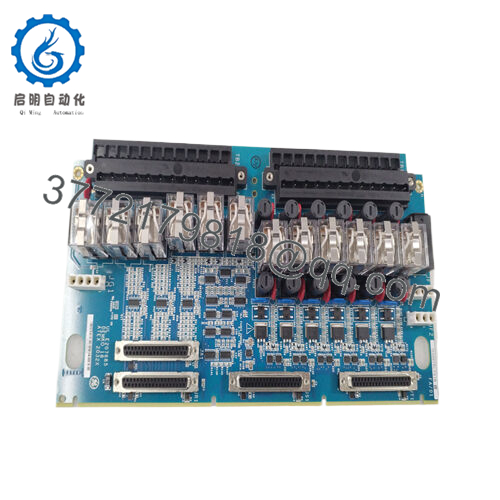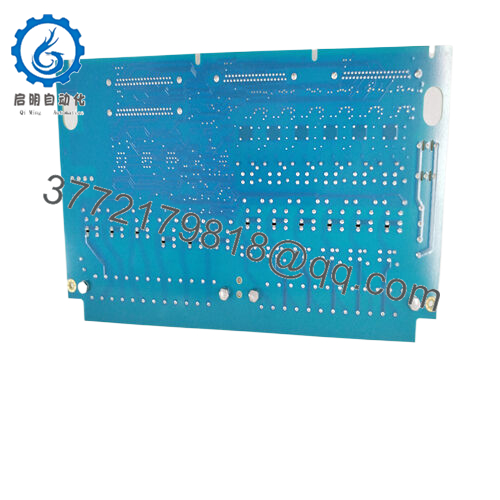Description
In the high-stakes world of turbine control and power generation, where relay failures or switching delays can trigger unsafe shutdowns or process interruptions—envision a gas turbine in a utility plant where a tripped auxiliary relay during startup exposes the system to overspeed risks and cascading alarms, or a steam cycle in an industrial cogenerator where isolated contact faults amid load shifts lead to valve mispositioning and efficiency losses—these vulnerabilities underscore the need for dependable output isolation in distributed control systems. Such pain points are all too common in legacy Mark VI architectures, where standard terminal boards overwhelm with wiring complexities or lack robust diagnostics, resulting in signal noise, integration snags, or maintenance overloads that extend downtime and compliance costs in high-reliability process control environments. The GE IS200TRLYS1B confronts this as a relay output terminal board from GE Vernova’s (formerly GE) Mark VI series, engineered to provide isolated, high-speed switching for control signals, ensuring precise I/O signal routing and fault-tolerant operation in demanding turbine management setups.
This board is essential in applications like retrofitting Mark V to VI for enhanced redundancy in aero-derivative turbines, where its compact design slots into existing cabinets without panel redesigns, or in manufacturing with synchronized drives needing Form C relays to isolate actuators from core logic. In a wind farm’s pitch control, for instance, it switches solenoid commands amid gust-induced transients, delivering reliable contacts to prevent blade stalls without nuisance trips. For offshore gas compression trains exposed to saline vibrations, the GE IS200TRLYS1B incorporates mechanical relays rated for 250 VAC/30 VDC at 2 A, upholding system stability in harsh zones. It’s a must-have for modular expansions in multi-unit plants, where its 12 Form C outputs bridge to exciters or valves, prioritizing goals like seamless diagnostics in EMI-dense or thermal-challenged enclosures.
- IS200TRLYS1B
- IS200TRLYS1B
Engineered with your priorities in mind—resilience and configurability—it supports up to 16 relay outputs with jumper-selectable options for custom isolation, adapting to 24 VDC inputs without derating. In arc-prone bays or grid-unstable sites, its galvanic barriers shield against transients, while status relays flag contact wear early. For teams modernizing Speedtronic systems, the GE IS200TRLYS1B bridges eras, reusing backplane standards to cut reconfiguration, redirecting efforts from relay roulette to reliable sequencing in industrial automation where output integrity safeguards every command.
Slipping the GE IS200TRLYS1B into your Mark VI architecture casts it as the isolation gateway for control outputs, where it terminates signals from core processors like VPRO via ribbon cables, driving 12 Form C mechanical relays for trip coils or interlocks in turbine cabinets. This board mounts in standard racks via edge connectors, positioning at the output termination layer—directly energizing field devices but relaying feedback through the Mark VI bus to HMIs for oversight. In a layered stack, it pairs with upstream <R> cores for sequencing or downstream PAII packs for analog tie-ins, distributing relay loads to avert single-point overloads.
In action, it handles switching at 10 A max per contact, with gold-flashed terminals for low-resistance paths in humid conditions, while auxiliary relays support TMR voting for redundant trips under 50 ms. Diagnostics integrate via LEDs and bus hooks, surfacing coil states or weld faults in ToolboxST for remote analysis—crucial in process control where off-site HMI trumps on-site probes. Without built-in power, it draws from rack supplies for 24 VDC operation, but its firmware enables online testing without de-energizing, while expandable configs scale to 16 outputs for phased arrays.
This versatility suits hybrid Mark VI nets: latch it into IP20 enclosures with shielded ribbons, set jumpers for NO/NC modes, and validate contacts with built-in stimulators to confirm against chatter. For backplane pros, the GE IS200TRLYS1B demystifies termination, turning raw outputs into isolated ensembles that adapt to relay counts, elevating industrial automation from wired woes to wired wins.
| Specification | Details |
|---|---|
| Model Number | IS200TRLYS1B |
| Brand | GE Vernova |
| Type | Relay Output Terminal Board (Mark VI Series) |
| Input Voltage | 24 VDC |
| Operating Temp Range | -30°C to 65°C |
| Mounting Style | Rack / Backplane |
| Dimensions | 10.16 x 16.51 x 2.54 cm |
| Weight | 0.8 kg |
| Interface/Bus | Ribbon Cable, Mark VI Bus |
| Compliance | CE, UL, RoHS |
| Supported Protocols | Mark VI Internal Bus |
| Typical Power Draw | 10 W |
Harnessing the GE IS200TRLYS1B yields switching surety that outpaces transient threats, its 12 Form C relays—rated 2 A at 250 VAC—energizing trips in <20 ms to avert overspeeds in startup sequences where delays desync protections and spawn halts. This robustness sustains isolation by gold-flashing contacts for 10 MΩ resistance, easing wear in cyclic duties and optimizing capex in valve-heavy ops, all within a slim profile that reuses Mark VI slots without vent tweaks.
The assimilation value deepens with Speedtronic rapport, where it repurposes ribbon layouts for add-ons like TMR interlocks, compressing tie-ins from days to diagnostics and lightening opex in turbine fleets. Upkeep refines via relay-embedded status that logs welds for proactive pulls, shortening hunts from coil checks to console cues—empowering crews for tuning over troubleshooting. Forged for bays laced with damp or dust, it clings to contact integrity over 65°C cycles, forestalling replacements and attuning to MTTR vows in regulated ops.
The enduring lens spotlights thrift catalysts—efficient 10 W footprint slims rack thermals, while jumper flexibility defers custom boards for leaner setups that yield to output booms. In high-reliability pursuits, the GE IS200TRLYS1B tempers total risks, from galvanic guards that nix grounds to monitor chains that norm drifts for spares, etching a relay web that braves barrages in turbine control.
In gas turbine auxiliaries, the GE IS200TRLYS1B switches fuel solenoid relays, isolating commands amid combustion roar to secure critical system uptime in process control environments where contact fidelity averts purge failures. Its high-reliability Form C outputs process I/O signals from sequencers, ensuring trip precision.
Steam bypass trains deploy it for valve interlocks under pressure jolts in boiler halls—yielding jumper-tuned paths for continuous cooldowns where chatter imperils turbine stress. In hydro wicket gates, it drives servo relays against water hammer in dam vaults, supporting modular TMR expansions. These roles exalt the GE IS200TRLYS1B as a relay ruler in grueling, command-crucial industrial automation, where terminal tenacity meets endurance.
IS200TRLYS1C – Updated variant with 16 relays for denser output needs in Mark VIe upgrades.
IS200RTDBH1A – Termination board companion for I/O signal routing.
IS200TREGH1A – Relay extension for TMR-voted tripping in safety loops.
IS200EXAMG1A – Analog module add-on for hybrid signal conditioning.
VPRO-I1 – Processor core mate for core-to-relay interfacing.
Mark VI Relay Kit – Jumper and diagnostic toolset for custom configs.
IS200TRLYS1A – Legacy model for basic Mark V retrofits.
IS420TRLYS1A – Mark VIe equivalent for enhanced diagnostics.
Before rack-seating the GE IS200TRLYS1B, confirm ribbon pinouts against your Mark VI chassis—mismatches ghost relays, so continuity-check with a meter if splicing revisions. Vet 24 VDC rails for <3% ripple, as hums chatter contacts; decouple with ferrites if core PSUs hum. Set jumpers per diagram for NO/NC before power-up, dodging init faults.
In tenure, husbandry pares to tactical glances that mesh with metrics. Monthly, eye relay LEDs for coil states—balanced activations affirm vigor, but stuck flags hail a manual pulse to clear welds. Quarterly, inject test voltages to probe resistance under 0.1 Ω, and swab terminals against oxide in humid holds. For TMR arms, semiannual voting drills gauge sync below 20 ms, wedded to annual rack-wide emulations with scope rigs to gage chatter bounds. Heeding GE’s Mark VI codex, this liturgy limns the GE IS200TRLYS1B as a tacit overlord, harvesting equity with stingy pulls in your output patrol.



 WhatsApp: +86 16626708626
WhatsApp: +86 16626708626 Email:
Email:  Phone: +86 16626708626
Phone: +86 16626708626


